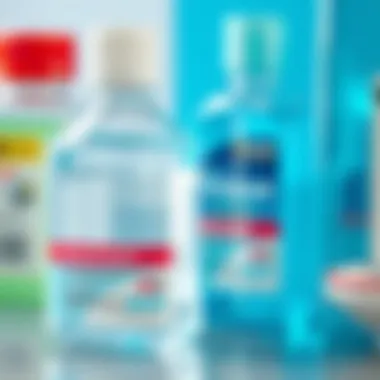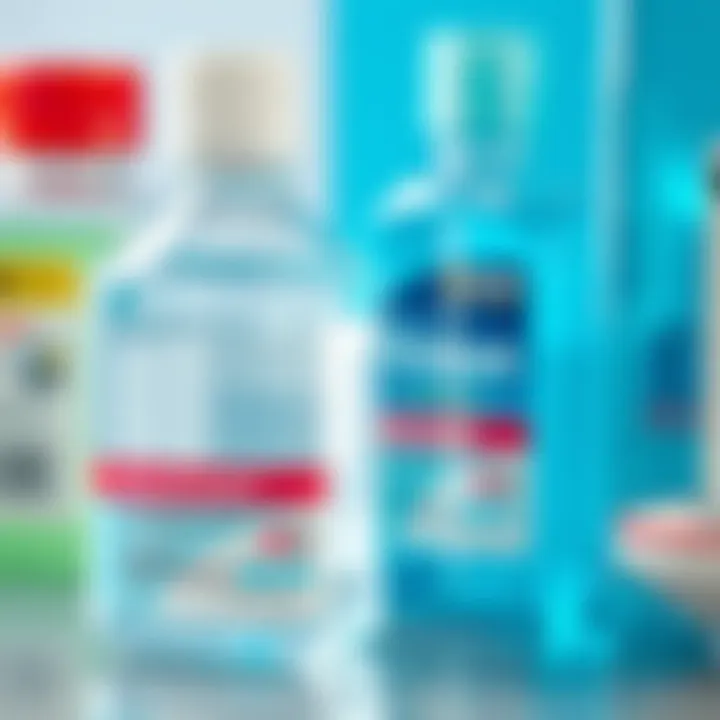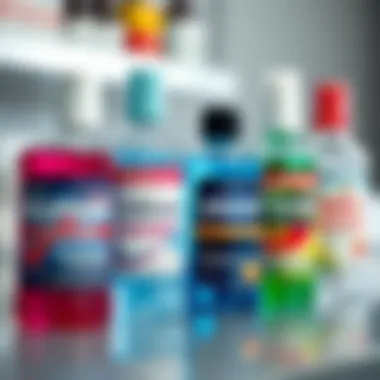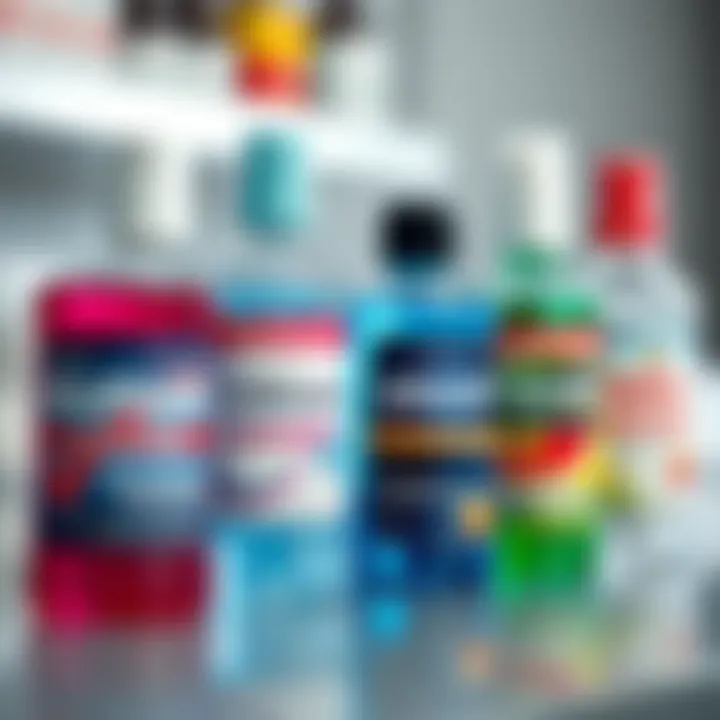Evaluating Triclosan Mouthwash Brands: Effectiveness and Safety


Intro
In the realm of oral hygiene, the choice of mouthwash brands carries significant weight. Among these products, triclosan mouthwash stands out, owing largely to its touted antibacterial properties. This article seeks to unpack the intricacies surrounding triclosan mouthwash brands, enhancing our understanding of the efficacy and safety of these products. With numerous options lining the shelves, it’s easy to feel overwhelmed. Consumers today are more discerning than ever, navigating through a sea of marketing claims and health implications.
Understanding the core features of triclosan mouthwash is imperative. More than just minty freshness, these products promise to tackle the bacteria that lead to plaque buildup, gingivitis, and bad breath. However, with recent discourse around health risks associated with triclosan, potential users may find themselves in a quandary about its use. This necessitates a thorough examination of not only the brands available but also the science underpinning their formulations.
The aim here is to provide a clear and concise guide that sheds light on the various aspects of triclosan mouthwash, enabling informed decisions regarding oral care. As we journey through this article, we'll explore the efficacy of these mouthwashes, delve into the safety concerns that have arisen, and look at how perception plays a crucial role in consumer choice.
Armed with actual data and clear comparisons, this piece strives to be a valuable resource for students, researchers, educators, and professionals who seek a deeper understanding of the often-overlooked elements of their daily oral care products.
Overview of Triclosan
Understanding triclosan is fundamental as we navigate the world of mouthwashes that include it. Triclosan, a synthetic antibacterial agent, has become a hot topic in oral care due to its effectiveness against bacteria in the mouth. However, with its benefits come discussions around safety and environmental concerns. It’s not just about keeping your breath fresh; it’s more about balancing efficacy with potential risks.
Chemical Properties of Triclosan
Triclosan, chemically known as 2,4,4'-trichloro-2'-hydroxydiphenyl ether, is characterized by its broad-spectrum antimicrobial properties. This compound is lipophilic, meaning it dissolves well in fats and oils, which enhances its ability to penetrate bacterial membranes. This penetration plays a crucial role in its effectiveness, allowing it to disrupt essential cellular processes in bacteria. Triclosan is also relatively stable and does not evaporate easily, which contributes to its lasting effects in various formulations, including mouthwash.
Moreover, its solubility in alcohol and its formulation versatility make it an attractive ingredient for many brands. However, its persistence raises questions about environmental impact as well.
Mechanism of Action
The way triclosan operates is quite fascinating. It works by inhibiting an enzyme found in bacteria called enoyl-acyl carrier protein reductase. This interference halts the bacteria's ability to synthesize fatty acids, which are essential for their cell membranes. Think of it as cutting off the supply lines; without functional membranes, the bacteria can't survive. This powerful mechanism is what gives triclosan its status as a formidable antibacterial agent.
But here’s where the conversation gets more nuanced. Overuse of triclosan in products might lead to resistance, as some bacteria evolve to withstand its effects. This raises eyebrows among health professionals, urging consumers to be well-informed and cautious.
"While triclosan can effectively combat biofilms and plaque, its long-term use requires careful consideration of health and environmental repercussions."
Overall, understanding both the chemical properties and the mechanism of action of triclosan provides a foundation for evaluating its role in oral care products, especially mouthwashes. As consumers, knowing how this compound functions can lead to better choices in maintaining oral hygiene.
Role of Triclosan in Oral Care
The role of triclosan in oral care is multifaceted, extending beyond mere antibacterial properties. It plays a significant part in the fight against common oral issues that can lead to more serious health consequences. Understanding its implications is vital for consumers seeking effective oral hygiene solutions. Triclosan is primarily recognized for its ability to target bacteria in the mouth, providing a protective barrier against infections. Its effectiveness in various formulas allows consumers to choose products that suit their specific dental health requirements.
Antimicrobial Effects
Triclosan possesses potent antimicrobial properties that make it a favorable ingredient in mouthwashes. This compound disrupts the cell membrane of bacteria, inhibiting their growth and proliferation. For instance, in studies, triclosan has shown an enhanced ability to reduce bacterial colonies that contribute to bad breath. You could say it goes head-to-head in a battle against oral pathogens, leaving a clean slate for healthier gums and teeth. Moreover, its long-lasting effects can provide added reassurance to users, minimizing the risk of infections after brushing or eating. This aspect is essential, especially for individuals with weakened oral health, where maintaining balance in the mouth's microbiome becomes crucial.
Plaque Reduction
One of the significant benefits of using triclosan mouthwash is its ability to reduce plaque formation. Plaque is a soft, sticky build-up of bacteria that can lead to more severe dental problems if not managed properly. Triclosan interferes with the bacteria that contribute to plaque formation, making it an effective preventive measure. Research indicates that using a triclosan-enriched mouthwash can result in noticeable improvements in plaque control when compared to non-triclosan products. Users often report feeling a cleaner mouth and fresher breath, which can significantly enhance their overall dental hygiene routine.
Efficacy Against Gingivitis
Gingivitis, characterized by inflammation and irritation of the gums, is a common condition that poses significant risks if left untreated. The efficacy of triclosan in managing gingivitis is well-documented. Using a mouthwash that contains triclosan can significantly reduce signs of gingival swelling and bleeding. In fact, many dental practitioners recommend these mouthwashes as part of a comprehensive oral care plan. This advantage stems from the ingredient’s ability to target specific bacterial strains linked to gum disease, providing much-needed relief and support to those grappling with this issue. While lifestyle choices and regular dental check-ups are vital, incorporating triclosan in oral care can serve as a robust ally in maintaining gum health.
"Incorporating triclosan mouthwash not only aids in reducing bacteria but also empowers users to take charge of their oral health."
Overall, the role of triclosan in oral care hinges on its scientific backing that correlates with its effectiveness against bacterial growth, plaque formation, and gum inflammation. As consumers weigh their options in oral hygiene products, understanding these dynamics becomes crucial to making informed choices that align with their health goals.
Popular Triclosan Mouthwash Brands
When it comes to oral hygiene, mouthwash plays a notable role in maintaining a healthy mouth and fresh breath. The focus on triclosan mouthwash brands in this discussion emerges from the compound’s recognized antimicrobial properties and its common use in various formulations across the market.
These mouthwashes offer benefits, particularly in combating harmful bacteria in the mouth. Yet, consumers should also consider the broader context—health risks associated with triclosan, environmental ramifications, and regulatory scrutiny. Understanding popular brands enables consumers to make informed choices regarding their oral care products. This analysis further encompasses effectiveness, safety, and user feedback, offering a holistic overview of what these products can provide.
Brand A: Features and Benefits
Brand A stands out among triclosan mouthwash offerings, combining a strong antibacterial formulation with user-friendly features. One of the prominent aspects is its dual-action formula, targeting both plaque and bad breath simultaneously.
Key features of Brand A include:
- Dual Action: It not only kills bacteria but also helps in soothing gum inflammation.
- Ease of Use: The mouthwash has a mild flavor that is not overpowering, making it suitable for daily use.
- Availability: Widely available in drugstores and online, this just adds to its appeal for consumers.
Feedback regarding Brand A has been generally positive, with many users appreciating its effectiveness without the burning sensation often associated with other mouthwashes. However, some users voiced concerns over its pricing, feeling that it may be on the higher end compared to similar products.


Brand B: Unique Selling Points
Brand B differentiates itself in the triclosan mouthwash market through its emphasis on natural flavoring and absence of artificial dyes. This marketing strategy particularly targets health-conscious consumers who prefer products free from synthetic additives.
The unique selling points include:
- Natural Ingredients: Incorporates natural extracts, which appeal to those avoiding synthetic compounds.
- Eco-Friendly Packaging: The brand prides itself on utilizing recyclable packaging, catering to environmentally aware buyers.
- Discount Offers: Consistently offers promotional deals, attracting budget-conscious consumers.
Consumer feedback indicates a growing preference for Brand B, especially among those concerned about ecological impacts. However, a few users have mentioned that they might not experience the same level of freshness compared to traditional brands.
Brand C: Customer Reviews and Feedback
Brand C rounds out the trio by providing a balanced blend of affordability and performance. It often garners attention in user reviews for its effectiveness against gingivitis and plaque buildup. Many consumers note that it delivers noticeable results within a few weeks of use.
In looking through customer feedback, several perceptions become clear:
- Value for Money: Many individuals feel they are getting a solid product without breaking the bank, making it an attractive option for budget-conscious buyers.
- Refreshing Taste: Users frequently comment on the refreshing mint taste, citing it as a pleasant aspect that leaves their mouths feeling clean.
- Concerns about Ingredients: While many appreciate its effectiveness, a segment of users expresses unease about using triclosan at all, indicating a desire for more transparent ingredient sourcing.
Controversies Surrounding Triclosan
The inclusion of triclosan in mouthwash has stirred up quite the hornet’s nest in recent years. While touted for its antibacterial properties, the debates surrounding its health implications and environmental ramifications have given many consumers pause. Exploring these controversies is crucial not just for consumers, but also for healthcare professionals and researchers who are invested in understanding the full spectrum of triclosan’s impact on public health and the planet.
Health Risks and Concerns
Debates about the health risks associated with triclosan often bring a mixed bag of studies and perspectives. One significant concern is its potential role in the development of antibiotic resistance. As triclosan is a powerful antibacterial agent, its widespread use could encourage the rise of resistant bacterial strains, making infections more difficult to treat.
Moreover, some studies have pointed to potential hormonal effects. For instance, research has indicated that triclosan can disrupt endocrine function, raising alarms about its impact on human health, particularly in vulnerable groups such as children and pregnant women. Issues like skin irritation and allergies have also been noted among users of products containing triclosan, giving rise to questions about its safety and long-term effects.
To put it in perspective:
- Antibiotic Resistance: Continued exposure may diminish the effectiveness of certain antibiotics.
- Hormonal Disruption: Alterations in hormone levels could lead to developmental issues in youth.
- Skin Reactions: Allergic responses might deter users from consistent mouthwash usage, negating the benefits.
Environmental Impact
The environmental considerations regarding triclosan cannot be shoved under the rug either. When rinsed down the drain, triclosan finds its way into waterways, which can devastate aquatic ecosystems. Fish and other wildlife may be exposed to this chemical, leading to bioaccumulation and potential harm to these populations.
Furthermore, triclosan has been detected in water sources, raising alarms about the implications for human consumption. The persistence of the chemical in the environment means that it could be detected long after its initial application, introducing another layer of complexity regarding its safety.
- Water Contamination: Triclosan can migrate into drinking water supplies, leading to unintentional human exposure.
- Impact on Wildlife: The disruption of aquatic ecosystems due to chemical exposure can have far-reaching consequences for biodiversity.
"Addressing these controversies is imperative for making informed choices about oral hygiene products that affect both individual health and the broader ecological balance."
In summary, as much as triclosan mouthwashes claim to provide stellar benefits for oral health, the surrounding debates compel us to rethink their role. Keeping these health and environmental concerns in mind allows consumers to weigh the pros and cons cautiously, leading to more informed decisions regarding the use of triclosan-containing products.
Regulatory Landscape
The regulatory landscape surrounding triclosan mouthwash is crucial for understanding not only the safety of these products but also their effectiveness in maintaining oral health. Regulations dictate how these products are developed, marketed, and sold. Notably, regulatory bodies like the U.S. Food and Drug Administration (FDA) implement standards that manufacturers must follow, ensuring that ingredients are appropriately tested and labeled. This offers consumers a degree of protection, as they can trust that what they are using has undergone scrutiny.
Understanding these regulations is paramount because it highlights the balance between consumer choice and public health. In a market filled with diverse products, regulatory frameworks can help to clarify what claims are legitimate. Moreover, they serve to prevent the dissemination of false or misleading health information — a significant concern given the societal emphasis on personal well-being.
"The goal of regulations is not merely to restrict creativity but to ensure that the marketplace operates safely and effectively for all consumers."
FDA Perspective
The FDA has played a vital role in the assessment of triclosan. Although it was once celebrated for its antimicrobial properties, the FDA has recently raised eyebrows regarding its safety in oral care products. The agency has consistently monitored the scientific evidence surrounding triclosan usage, emphasizing that while it was approved for certain applications, ongoing research has cast shadows over its long-term implications.
One major concern highlighted by the FDA is the potential for triclosan to contribute to antibiotic resistance. This stems from its prolonged use, which could allow bacteria to evolve and develop resilience against not just triclosan but other antibacterial agents as well. In addition, there are questions surrounding potential endocrine-disrupting effects that the ingredient may have. These concerns have led the FDA to reassess its position and encourage continuous research.
Global Regulatory Trends
Beyond the United States, various countries have adopted their own regulatory frameworks governing the use of triclosan in personal care products. For instance, the European Union has taken a more conservative approach by placing restrictions on the concentration of triclosan allowable in consumer goods. This indicates a broader acknowledgment of the potential health and environmental risks associated with the compound.
In regions such as Canada and Australia, similar scrutiny is observed, with respective health agencies conducting reviews to determine the safety and efficacy of triclosan-containing products. This global perspective showcases an accumulating caution toward the ingredient, reflecting a trend where health authorities seek to prioritize consumer safety over commercial interests.
As one examines the varying regulations worldwide, it is clear that a growing movement towards safer, more sustainable alternatives is underway. The push toward transparency and thorough evaluations places emphasis on public health while also urging manufacturers to innovate in safer directions. This regulatory trend has a profound impact on how products are marketed and what consumers ultimately purchase.
Alternatives to Triclosan Mouthwash


As the conversation about triclosan and its role in oral care moves forward, many consumers are on the lookout for alternative mouthwash options. The focus is shifting not only towards the efficacy of the products on the shelves but also, significantly, towards the ingredients they contain. Given the growing scrutiny over triclosan's safety and its potential health impacts, understanding the alternatives becomes pivotal. This section delves into different types of mouthwashes available, each one offering unique benefits while ensuring oral hygiene.
Alcohol-Free Options
Alcohol-free mouthwashes have gained traction in recent years, primarily due to their gentler formula. Traditional mouthwashes often contain alcohol, which can cause dryness and irritation in the mouth. Not only can this lead to discomfort, but it may also exacerbate certain conditions such as dry mouth (xerostomia).
The absence of alcohol in these options aims to maintain moisture levels in the mouth, which can be particularly beneficial for individuals with sensitive gums or those who experience discomfort from regular mouthwash. Moreover, many alcohol-free formulations also include essential oils or other therapeutic agents—such as cetylpyridinium chloride—that effectively combat bacteria without the harsh effects of alcohol.
Here are some common benefits of alcohol-free mouthwashes:
- Gentle on gums: Reduced irritation for sensitive oral tissues.
- Moisturizing: Helps maintain moisture balance in the mouth.
- Variety of flavors: Often available in pleasant flavors that are more appealing.
- Suitable for all ages: A better choice for children and individuals recovering from dental work.
"Alcohol-free mouthwashes can be the safe bet, especially for those looking to maintain oral health while minimizing irritation."
Natural Ingredients
Natural ingredient mouthwashes have captured the intention of the eco-conscious consumer. These products leverage plant-based components, such as aloe vera, tea tree oil, or coconut oil, believed to possess inherent antibacterial properties. The argument for natural mouthwashes is anchored in the idea that fewer synthetic chemicals translate to a healthier product for both the user and the environment.
Natural mouthwashes tend to promote overall oral health more holistically, aiming not just to kill bacteria but also to soothe and nurture the gums. The following are often highlighted as key benefits of natural ingredient mouthwashes:
- Minimized chemical exposure: Reduced reliance on synthetic preservatives and alcohol.
- Eco-friendly: Generally produce less environmental impact during production and disposal.
- Holistic health: Many natural ingredients, like xylitol and herbal extracts, support healthy gums and fresh breath.
It's worth checking the labels to ensure the efficacy of these natural ingredients. Some brands focus heavily on plant extracts that offer direct support against bacteria while still ensuring a fresh mouthfeel.
Herbal Mouthwashes
Herbal mouthwashes represent another subset of these alternatives, designed to harness the power of traditional remedies. Infused with botanical extracts like sage, peppermint, or eucalyptus, these restoratives often aim to provide both antibacterial and anti-inflammatory benefits.
The appeal of herbal mouthwashes lies in their traditional roots and perceived safety. Many people find comfort in using products that are derived from time-honored herbal remedies, often associated with holistic health practices. Some essential features include:
- Natural flavors: These often produce a pleasant taste and aroma, enhancing the user experience.
- Antimicrobial properties: Certain herbs are well-known for their ability to combat oral pathogens.
- Soothing effects: Ingredients like chamomile can help reduce irritation and inflammation in the mouth.
In summary, as consumers step back and reconsider which mouthwash products are best suited for their oral care, these alternatives to triclosan mouthwash offer compelling options. By exploring alcohol-free options, natural ingredients, and herbal formulations, individuals can choose wisely based on their unique needs and health considerations. It’s an ongoing journey in the quest for effective and safe oral hygiene.
How to Choose the Right Mouthwash
Choosing the right mouthwash isn't just a walk in the park; it's a crucial decision that can echo greatly in your oral hygiene routine. With an array of options flooding the market, understanding how to navigate these choices can make all the difference in maintaining a healthy mouth. Given the growing concerns surrounding ingredients like triclosan, it’s vital to approach your selection with a discerning eye. Here, we’ll delve into essential considerations that can guide your path to a well-informed choice regarding mouthwash.
Understanding Ingredients
It’s often said that knowledge is power, and this rings particularly true when it comes to the ingredients listed on your mouthwash bottle. Dissecting the components can help you identify the products that align with your health and wellness values. Triclosan is a well-known antiseptic, but it’s not the only ingredient to keep on your radar. Here are some common ingredients you might encounter and what they bring to the table:
- Fluoride: This mineral is celebrated for its cavity-fighting properties and is often a key ingredient in mouthwashes designed to strengthen enamel.
- Essential Oils: Ingredients like eucalyptus and tea tree oil are praised for their natural antibacterial properties. They offer an alternative for those wary of synthetic chemicals.
- Alcohol: Many mouthwashes contain alcohol to enhance their antiseptic qualities. However, some may find it too harsh, leading to dryness or irritation in the mouth.
- Glycerin: Often included for its moisturizing quality, glycerin can help avoid discomfort while rinsing.
When assessing these ingredients, reflect on how they might interact with your personal health needs. For instance, if you tend to experience dry mouth, you might want to steer clear of alcohol-heavy options.
Brand Reputation
Not all mouthwash brands are created equal, and the reputation of a brand can often hint at the quality and efficacy of its products. A brand that has built a solid reputation tends to stand behind its product integrity, often supported by credible research and consumer satisfaction.
Consider the following aspects when evaluating brand reputation:
- Consumer Reviews: Reading reviews can provide insight into the effectiveness and taste of a mouthwash from the perspective of users. Look for consistent feedback on aspects like flavor, freshness, and any oral health improvements.
- Clinical Trials: Brands that invest in clinical studies and provide transparency about their findings signal a commitment to efficacy.
- Certifications and Endorsements: Look for products that are endorsed by dental associations or contain certifications that reaffirm their safety and effectiveness.
A reputable brand isn’t merely about flashy packaging or clever slogans; it reflects trustworthiness in its commitment to consumer health.
Price Considerations
When it comes to mouthwash, cost can sometimes feel like a double-edged sword. Higher prices don’t always guarantee better efficacy, and conversely, rock-bottom prices can raise eyebrows about ingredient quality. Finding a balance is essential.
Things to think about when evaluating price include:
- Cost-Effectiveness: Sometimes buying in bulk or opting for larger bottles can save some cash in the long run.
- Value for Money: Analyze whether the benefits of a specific mouthwash justify its price tag. Products with proven efficacy might warrant a higher cost.
- Promotions and Discounts: Keep an eye out for promotions or coupons. Brands often run sales that might make pricier options more accessible.
Ultimately, investing in a mouthwash shouldn't break the bank, yet it’s essential to also consider the impact of your choice on your oral hygiene.


"Choosing the right mouthwash is not just about taste; it's about aligning your choice with your health priorities."
By keeping these considerations in mind, choosing the right mouthwash can become less of an overwhelming task and more of a thoughtful process. Your mouth deserves the best, and arming yourself with the right information ensures that you make a decision that works for your unique needs.
Proper Usage of Mouthwash
Using mouthwash correctly is essential for maximizing its benefits in your oral care routine. Though many believe it's simply a matter of swishing and spitting, the nuances of proper usage can significantly impact your oral hygiene. Mouthwash can freshen breath, reduce plaque, and prevent gum disease, but using it properly is the key.
Frequency of Use
The frequency at which you use mouthwash plays a crucial role in effective oral care. Most dental health professionals recommend using mouthwash at least twice a day, preferably following meals. This ensures that any bacteria that accumulate from food consumption are addressed promptly. However, it's vital to note that overuse may have unintended effects, such as altering the natural balance of oral bacteria, which could potentially lead to issues like dry mouth or altered taste sensations.
Regular use of mouthwash is paramount, yet moderation remains a prudent approach to prevent disruptions to your oral flora.
When considering how often to use mouthwash, factor in your personal dental health needs. Individuals with specific conditions, like gum disease or a history of cavities, may benefit more from an increased frequency. However, those with sensitive gums might find it more comfortable to reduce usage. Always consult your dentist to tailor a routine that suits your needs, balancing the benefits against any potential drawbacks.
Dilution and Application
Another aspect of proper mouthwash usage is understanding the dilution and application process. Most mouthwashes come ready-to-use, but some formulas, particularly those with stronger active ingredients, might require dilution with water. Check the label to ensure you are adhering to manufacturers' recommendations.
When applying mouthwash:
- Measure the right amount: Typically, a capful is sufficient—around 20 mL is a good rule.
- Swish thoroughly: Ensure you swirl the liquid around your mouth for at least 30 seconds to a minute. This duration allows the active ingredients to effectively combat bacteria.
- Do not swallow: Mouthwash is meant to be an oral rinse, not a drink. Swallowing might lead to unwanted side effects depending on the ingredients.
- Avoid rinsing: After spitting the mouthwash out, resist the temptation to rinse your mouth with water. This can wash away the beneficial agents left behind, diminishing its effectiveness.
Understanding these foundational elements of mouthwash usage equips individuals to leverage its full potential effectively. With the proper frequency and application techniques, one can significantly enhance their dental health journey.
Consumer Perspectives
Understanding consumer perspectives on triclosan mouthwash brands is crucial because it shapes the way the market functions and responds. This section aims to shed light on the nuances of what consumers think and feel about these products. Feedback from everyday users not only offers insight into effectiveness but also communicates evolving attitudes towards health and hygiene products.
When consumers decide on mouthwash, they often weigh various factors, including brand reputation, product efficacy, and price. The conversation has shifted over recent years, with buyers becoming more knowledgeable and discerning about ingredients and their implications. Therefore, the benefits of dissecting consumer perspectives are numerous:
- Informed Decision-Making: Today’s consumers are increasingly doing their homework, researching online and looking for expert reviews before making a purchase. They want to know if triclosan mouthwash lives up to its claims. Some studies point towards effectiveness, while others raise eyebrows regarding its safety and environmental impact.
- Preference Shifts: Trends indicate a growing preference for natural ingredients, leading some consumers to explore alternatives to triclosan-based products. This has implications for companies looking to market their mouthwashes, as they must adapt to the changing consumer landscape. Amid the decline of traditional expectations lies an opportunity for new companies that may emphasize eco-friendliness or organic components.
- Social Impacts: The influence of community conversations, particularly on platforms like Reddit or Facebook, cannot be underestimated. Many buyers turn to social media for recommendations, and influencers can sway opinions significantly. A product might gain traction due to a favorable review or, conversely, suffer backlash from negative experiences shared among users.
"Consumer opinions today are shaped not just by product performance, but by a holistic view of its impact on health and the community."
Gaining a complete understanding of consumer perspectives enables manufacturers to innovate and market their products more effectively. Engaging with audience concerns—be it about safety or taste options—ultimately allows brands to speak directly to their customers' needs and preferences.
Market Trends and Preferences
As we peel back the layers on market trends, we see a noticeable shift in consumer requirements. Those buying mouthwash are more inclined to scrutinize labels closely these days. Preferences vary significantly across demographics, but common trends emerge:
- Health Consciousness: Buyers are notably attuned to health risks associated with common mouthwash ingredients, such as triclosan. There is a desire for transparency in ingredients and a preference to steer clear of chemical additives when possible.
- Environmental Awareness: Increased concern for environmental issues has led consumers to favor brands that use sustainable practices. Many buyers now prefer mouthwash products that claim to be biodegradable or packaged in recyclable materials.
- Flavor and Experience: Traditional mint flavors still rule, but there's a significant rise in demand for unique flavors. Consumers are enjoying experimenting with new tastes like charcoal, coconut, or even herbal blends, adding an element of personalization to their oral hygiene routine.
Influence of Advertising
The role of advertising in shaping consumer attitudes towards triclosan mouthwash cannot be overlooked. Companies invest heavily in marketing to differentiate their brands in a saturated market. The narrative they create influences potential buyers.
- Messaging and Brand Image: Brands often focus on the antibacterial properties of triclosan while downplaying any negative connotations associated with the ingredient. They craft messages highlighting effectiveness against plaque and gingivitis, as well as endorsing clinical studies that support their claims.
- Celebrity Endorsements: Influencers and celebrities endorse various brands on social media platforms, creating a buzz that cannot be ignored. These endorsements can lead to an instant surge in popularity and sales, as consumers often trust familiar personalities over traditional advertising methods.
- Social Proof: Reviews and testimonials play a pivotal role in public perception. Positive feedback on platforms like Amazon or user-generated content on social media can catapult a brand to success, whereas negative reviews can damage reputations irreparably. Consumers nowadays tend to rely heavily on peer reviews when considering new products.
By understanding how advertising shapes perceptions, brands can tailor their strategies to resonate with consumers, fostering long-term loyalty and trust.
Future of Triclosan in Oral Care
The landscape of oral care is constantly evolving, and the future of triclosan in this realm remains a topic of heated discussion. New research is propelling our understanding of triclosan's role in mouthwash formulations, while consumers grow more discerning about what they put into their bodies. There's a palpable tension between the tried-and-true benefits of triclosan's antibacterial properties and the growing concerns surrounding health and environmental implications.
In the past, triclosan has garnered a reputation as a powerful antimicrobial agent, particularly in mouthwashes, which aim to combat dental plaque and gingivitis. Despite its efficacy, scrutiny over its safety is leading some brands to reconsider their formulations. The future may not merely involve more rigorous tests but rather an authentic engagement with consumer concerns and preferences.
Emerging Research
Recent studies have begun to shine a light on the multi-faceted implications of triclosan in oral hygiene products. Researchers are diving deep into the potential impacts on not just oral health but overall well-being. For instance, there's ongoing research examining how triclosan interactions with other ingredients may enhance or reduce its effectiveness. This is particularly critical as companies aim for formulations that not only adhere to safety standards but also maximize efficacy.
Moreover, studies are exploring the long-term consequences of triclosan usage in mouthwash. Some results suggest that regular exposure could influence the bacterial ecology within the mouth, fostering resistant strains. As such, researchers are focusing on finding the sweet spot between maintaining oral health without unintentionally developing resistance issues. This evolving body of research could fundamentally change how brands position triclosan on their ingredient lists.
Potential Innovations
With advances in technology and continual consumer feedback, innovative formulations may soon emerge that balance safety with effective oral care. Brands are already brainstorming substitutes for triclosan or modifying its use in ways that align better with safety standards while retaining its desirable qualities.
There are conversations around incorporating natural antimicrobials and probiotics into mouthwashes, which may provide a gentler solution for maintaining oral hygiene. These innovations could lead to products that not only fight bacteria but also promote a healthier oral microbiome.
Some companies are also investing in advanced delivery systems for these ingredients, allowing for better penetration and longer-lasting effects. Consumers may soon see a wave of products that leverage novel active ingredients alongside traditional ones, meaning mouthwash may become as tailored and unique as the individual using it.
"As the industry evolves, the focus on consumer health and safety cannot be overstated. It's clear that what was once accepted must now be thoughtfully reconsidered."







